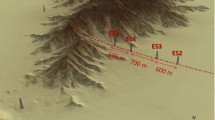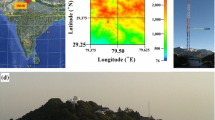Abstract
The effect of topographical slope angle and atmospheric stratification on turbulence intensities in the unstably stratified surface layer have been parameterized using observations obtained from a three-dimensional sonic anemometer installed at 8 m height above the ground at the Seoul National University (SNU) campus site in Korea for the years 1999–2001. Winds obtained from the sonic anemometer are analyzed according to the mean wind direction, since the topographical slope angle changes significantly along the azimuthal direction. The effects of the topographical slope angle and atmospheric stratification on surface-layer turbulence intensity are examined with these data. It is found that both the friction velocity and the variance for each component of wind normalized by the mean wind speed decrease with increase of the topographical slope angle, having a maximum decreasing rate at very unstable stratification. The decreasing rate of the normalized friction velocity (u * /U) is found to be much larger than that of the turbulence intensity of each wind component due to the reduction of wind shear with increase in slope angle under unstable stratification. The decreasing rate of the w component of turbulence intensity (σ w /U) is the smallest over the downslope surface whereas that of the u component (σ u /U) has a minimum over the upslope surface. Consequently, σ w /u * has a maximum increasing rate with increase in slope angle for the downslope wind, whereas σ u /u * has its maximum for the upslope wind. The sloping terrain is found to reduce both the friction velocity and turbulence intensity compared with those on a flat surface. However, the reduction of the friction velocity over the sloping terrain is larger than that of the turbulence intensity, thereby enhancing the turbulence intensity normalized by the friction velocity over sloping terrain compared with that over a flat surface.
Similar content being viewed by others
References
Al-Jiboori M.H., Yumao X. and Yongfu Q. (2001). ‘Turbulence Characteristics over Complex Terrain in West China’. Boundary-Layer Meteorol 101: 109–126
Binkowski F.S. (1979). ‘A Simple Semi-empirical Theory for Turbulence in the Atmospheric Surface Layer’. Atmos. Environ. 13: 247–253
Bradley E.F. (1980). ‘An Experimental Study of the Profiles of Wind Speed, Shearing Stress and Turbulence at the Crest of a Large Hill’. Quart. J. Roy. Meteorol. Soc 106: 101–123
Businger J.A. (1955). ‘On the Structure of the Atmospheric Surface Layer’. J. Meteorol 12: 553–561
Businger J.A., Wyngaard J.C., Izumi Y. and Bradley F.E. (1971). ‘Flux-Profile Relationships in the Atmospheric Surface Layer’. J. Atmos. Sci 28: 181–189
Carruthers, D. J. and Hunt, J. C. R.: 1990, ‘Fluid Mechanics of Airflow over Hills: Turbulence, Fluxes, and Waves in the Boundary Layer’, in W. Blumen (ed.). Meteorological Monographs Vol. 23 Atmospheric Processes over Complex Terrain:Amer. Meteorol. Soc. 83–103.
Duijm N.J. (1999). ‘Estimates of Roughness Parameters for Arrays of Obstacles’. Boundary-Layer Meteorol 91: 1–22
Foken T. and Wichura B. (1996). ‘Tools for Quality Assessment of Surface-Based Flux Measurements’. Agric. and Forest Meteorol 78: 83–105
Founda D., Tombrou M., Lalas D.P. and Asimakopoulos D.N. (1997). ‘Some Measurements of Turbulence Characteristics over Complex Terrain’. Boundary-Layer Meteorol 83: 221–245
Gallagher M.W., Choularton T.W. and Hill M.K. (1988). ‘Some Observations of Airflow over a Large Hill of Moderate Slope’. Boundary-Layer Meteorol 42: 229–250
Kader B.A. and Yaglom A.M. (1990). ‘Mean field and Fluctuation moments in Unstably Stratified Turbulent Boundary Layers’. J. Fluid Mech 212: 637–662
Kai K. (1982). ‘The Budget of Turbulent Energy Measured at the ERC 30-m Meteorological Tower’. J. Meteorol. Soc. Japan II 60: 1117–1131
Kaimal J.C. and Finnigan J.J. (1994). Atmospheric Boundary Layer Flows – Their Structure and Measurement. Oxford University Press, New York, 289
Kaimal J.C. and Gaynor J.E. (1991). ‘Another Look at Sonic Thermometry’. Boundary-Layer Meteorol 56: 401–410
Kaimal J.C., Wyngaard J.C., Izumi Y. and Cote O.R. (1972). ‘Spectral Characteristics of Surface-Layer Turbulence’. Quart. J. Roy. Meteorol. Soc 98: 563–589
Lettau H. 1949, ‘Isotropic and Non-Isotropic Turbulence in the Atmospheric Surface Layer’. Geophys. Res. Paper No. 1, Air Force Cambridge Res. Labs, Bedford, Mass.
Mahrt L., Vickers D., Sun J., Jensen N.O., Jorgensen H., Pardyjak E. and Fernando H. (2001). ‘Determination of the Surface Drag Coefficient’. Boundary-Layer Meteorol 99: 249–276
Monin A.S. and Obukhov A.M. (1954). ‘Basic Laws of Turbulent Mixing in the Atmospheric Mixing Layer’. Trudy Geofiz. Inst. Akad. Nauk SSSR 24(151): 163–187
Panofsky H.A. and Dutton J.A. (1984). Atmospheric Turbulence – Models and Methods for Engineering Applications. John Wiley & Sons, New York, 397
Panofsky H.A., Larko D., Lipschutz R., Stone G., Bradley E.F., Bowen A.J. and Hojstrup J. (1982). ‘Spectra of Velocity Components over Complex Terrain’. Quart. J. Roy. Meteorol. Soc 108: 215–230
Panofsky H.A., Tennekes H., Lenschow D.A. and Wyngaard J.C. (1977). ‘The Characteristics of Turbulence Velocity components in the Surface Layer under Convective Conditions’. Boundary-Layer Meteorol 11: 355–361
Raupach M.R. (1994). ‘Simplified Expressions for Vegetation Roughness Length and Zero-Plane Displacement as Functions of Canopy Height and Area Index’. Boundary-Layer Meteorol 71: 211–216
Roth M. (1993). ‘Turbulent Transfer Relationships over an Urban Surface II: Integral Statistics’. Qurat. J. Roy. Meteorol. Soc 119: 1105–1120
Swinbank W.C. (1964). ‘The Exponential Wind Profile’. Quart. J. Roy. Meteorol. Soc 93: 119–135
Yasuda N. (1978). ‘High-Order equations of Turbulence and Characteristics of Turbulence Based on their Simple Solution in the Atmospheric Boundary Layer near the Ground’. Pap. Meteorol. Geophys 29: 109–129
Zhang H., Chen J. and Park S.-U. (2001). ‘Turbulence Structure in Unstable Conditions over Various Surfaces’. Boundary-Layer Meteorol 100: 243–261
Author information
Authors and Affiliations
Corresponding author
Rights and permissions
About this article
Cite this article
Park, MS., Park, SU. Effects of Topographical Slope Angle and Atmospheric Stratification on Surface-Layer Turbulence. Boundary-Layer Meteorol 118, 613–633 (2006). https://doi.org/10.1007/s10546-005-7206-x
Received:
Published:
Issue Date:
DOI: https://doi.org/10.1007/s10546-005-7206-x




